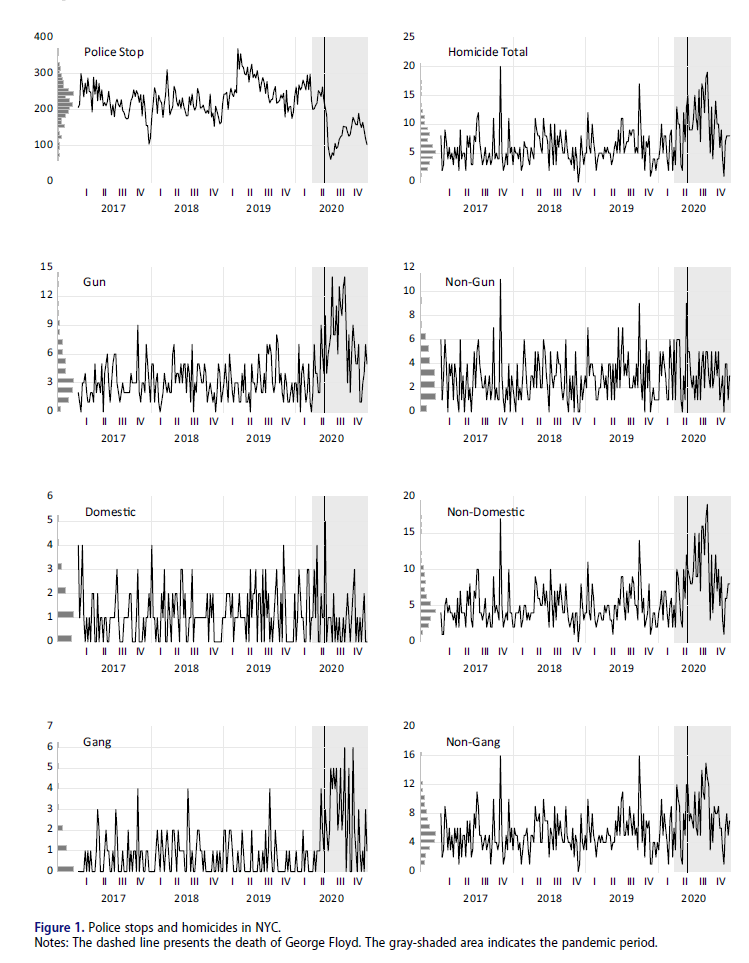It is well known that there were significant spikes in homicides in 2020, particularly in major urban areas. In an article I published in 2021, I attributed these spikes to what I dubbed the "Minneapolis Effect"–specifically reductions in proactive policing as police pulled back in the wake of the George Floyd protests. I blogged about my article here.
A few days ago, an important new statistical study found corroboration for my hypothesis in New York City. Professor Dae-Young Kim's article "Did De-Policing Contribute to the 2020 Homicide Spikes?" answers the question posed in the title in the affirmative.
Professor Kim's article examines NYC homicide data from 2017 through 2020. It divides homicides into six different categories: gun, non-gun, domestic, non-domestic, gang, and non-gang. It assesses the connection between homicide rates in those categories and a significant reduction in NYPD police stops of pedestrians. In NYC, stops fell from 13,453 in 2019 to 8,375 in 2020–a 30% decrease in proactive policing.
Professor Kim's article found that the reduction in stops led to an increase in three homicide categories:
… the interaction term of police stops and the pandemic presents the extent to which the 2020 homicide surges were attributable to reduced proactive law enforcement. Specifically, gun, non-domestic, and gang homicides significantly increased as police stops decreased in the pandemic and post-Floyd era. In addition, the supplementary correlation analyses present a significant correlation of police stops to gun (r=−.406, p =.008), non-domestic (r=-.321, p=.041), and gang (r=−.364, p=.019) homicides, respectively, in the pandemic and post-Floyd era. In contrast, the significant correlations disappear in the pre-intervention era.
While the full article is behind a paywell, one can gain a quick sense of the strength of Professor Kim's analysis by looking at graphs depicting NYC police stops, total homicides, and the six homicide categories described above:

In the first of the eight charts above, the reader can see the dramatic reduction in police stops by NYPD following the George Floyd protests. In the remaining charts, the simultaneous significant increase in homicides in the gun, non-domestic, and gang categories (but non in non-gun, domestic, and non-gang categories) is visually evident.
The explanation Professor Kim gives for this pattern tracks the one that I gave in my paper on the "Minneapolis Effect"–specifically, that police stops are targetted at gun crimes and related gang activity, and thus a reduction in stops will produce the greatest increase in homicides in these specific categories. As Professor Kim puts it:
Pedestrian stops are used to stop and frisk anyone, but mostly known gang members, on the street they suspect might engage in criminal activity or carry concealed weapons. Given the goal of pedestrian stops, the effects of de-policing should be more pronounced on gun, non-domestic, and gang homicides that usually occur in public settings. The current findings echo Piza and Connealy's (2022) study in that the lack of policing caused crime increases, ultimately compromising public safety and endangering communities.
In an earlier paper on the 2016 Chicago homicide spikes, Professor Fowles and I saw a similar pattern in the Chicago data.
Professor Kim's findings support the conclusions that I reached in my paper on the "Minneapolis Effect" about the compelling need to increase proactive policing. Here is the conclusion from my earlier article:
The quantitative data and qualitative evidence strongly suggest that a "Minneapolis Effect" has struck—that is, in the wake of antipolice protests following George Floyd's death in Minneapolis, police officers are being redeployed from antigun efforts and are retreating from proactive law enforcement tactics. This reduction in law enforcement efforts targeted at firearm crimes has led, perhaps predictably, to an increase in firearm crimes.
This article attempts to quantify the size of the Minneapolis Effect, estimating that about 710 more homicides and 2,800 more shootings occurred because of reduced policing in June and July alone. And the victims of these crimes are disproportionately Black and Brown, often living in disadvantaged and low-income neighborhoods.
While these estimates are stated in the cold precision of an economic calculation, it must be remembered that behind these grim numbers lies a tremendous toll in human suffering—lives lost, futures destroyed, and families left grieving. Understanding the nation's recent—and ongoing—homicide spikes requires urgent attention. And even more urgently, the nation needs to consider all possible responses to this tragedy, including responses that involve increased and proactive law enforcement efforts directed at combating gun violence.
The post New Statistical Evidence Supports the "Minneapolis Effect" as an Explanation for Increases in Homicides appeared first on Reason.com.







